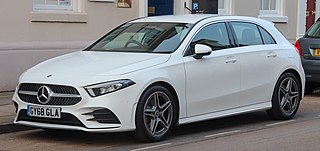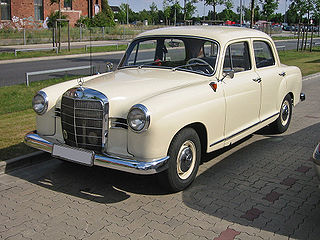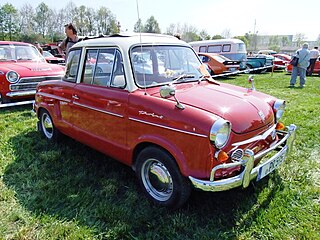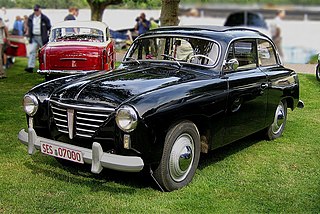
The Ford Taunus is a family car that was sold by Ford Germany throughout Europe. Models from 1970 onward were built on the same basic construction as the Ford Cortina MkIII in the United Kingdom, and later on, the two car models were essentially the same, differing almost only in the placement of the steering wheel. The model line was named after the Taunus mountain range in Germany, and was first made in 1939, and continued through several versions until 1994.

The Mercedes-Benz 300 SEL 6.3 was a full-sized luxury performance car built by Mercedes Benz from 1968 to 1972. It featured the company's powerful 6.3-litre M100 V8 from the flagship 600 (W100) limousine installed in the normally six-cylinder powered Mercedes-Benz 300 SEL (W109). The result was a nearly 2-ton sports sedan with muscle car performance. At the time of its release it was the world's fastest four-door car until the 1971 release of the 228km/h XY GTHO III by Ford Australia.

The Mercedes-Benz 300 SL is a two-seat sports car which was produced by Mercedes-Benz as a gullwinged coupe (1954–1957) and roadster (1957–1963). It was based on the company's 1952 racer, the W194, with mechanical direct fuel injection which boosted power almost 50 percent in its three-liter overhead camshaft straight-six engine. Capable of reaching a top speed of up to 263 km/h (163 mph), it was a sports car racing champion and the fastest production car of its time.

The Mercedes-Benz W201 was the internal designation for the Mercedes 190 series sedans, a range of front-engine, rear drive, five passenger, four-door sedans manufactured over a single generation, from 1982 to 1993 as the company's first compact class automobile.

The Volkswagen Fox is a subcompact car produced and designed by Volkswagen of Brazil and sold in Latin America from 2003 until 2021 and in Europe from 2005 until 2011, where it was sold as the city car offering. The Fox was produced as a 3-door and 5-door hatchback. There is also a mini SUV version called Fox Xtreme and a mini MPV/station wagon model called Suran, SpaceFox, SportVan or Fox Plus depending on the market.

The Mercedes-Benz A-Class is a subcompact car produced by the German automobile manufacturer Mercedes-Benz as the brand's entry-level vehicle. The first generation was introduced in 1997, the second generation (W169) in late 2004 and the third generation (W176) in 2012. The fourth generation model (W177), which was launched in 2018, marked the first time the A-Class was offered in the United States and Canada. This fourth generation A-Class is also the first to be offered both as a hatchback (W177) and sedan (V177).

The Mercedes-Benz W 120 and Mercedes-Benz W 121 are technically similar inline-four cylinder sedans made by Daimler-Benz. The W 120 was first introduced by Mercedes-Benz in 1953. Powered initially by the company's existing 1.8 liter M 136 engine, it was sold as the Mercedes-Benz 180 through 1962. From 1954, Mercedes-Benz also offered the W 120 with a diesel engine as the Mercedes-Benz 180 D. The Mercedes-Benz W 121 was introduced as the Mercedes-Benz 190 in 1956, powered by a 1.9 liter M 121 engine. From 1958, the W 121 was also offered with an OM 621 engine, sold as the Mercedes-Benz 190 D through 1961.

The Opel Manta is a rear-wheel-drive sports coupé built by German manufacturer Opel in two generations from 1970 to 1988. The Manta was a mildly sporting coupé based on the Ascona family car, akin to the Ford Falcon-based Mustang and its various imitators such as the Ford Capri. The Manta remained rear-wheel drive for both generations and also saw certain competition success. Its name comes from the Manta ray.

The NSU Prinz (Prince) is an automobile which was produced in West Germany by the NSU Motorenwerke AG from 1958 to 1973.

The European Ford Granada is a large executive car manufactured by Ford Europe from 1972 until 1994.

The BMW 501 was a luxury car manufactured by BMW from 1952 to 1958. Introduced at the first Frankfurt Motor Show in 1951, the 501 was the first BMW model to be manufactured and sold after the Second World War, and as the first BMW car built in Bavaria. The 501 and its derivatives, including the V8 powered BMW 502, were nicknamed “Baroque Angels” by the German public. The BMW 502 was the first postwar German car to be manufactured with a V8 engine.

The Goliath GP700 is a small automobile which was manufactured by the Bremen, Germany–based Borgward subsidiary Goliath-Werke Borgward & Co from 1950 to 1957. In 1955, the GP700 was joined by the larger-engined Goliath GP900 E. From 1951 to 1953, a coupé version, the Goliath GP700 Sport was offered. The Goliath was a revolutionary design, which in several important respects pointed the way for automobile development in the second half of the 20th century.

The Mercedes-Benz 500K (W29) is a grand touring car built by Mercedes-Benz between 1934 and 1936. First exhibited at the 1934 Berlin Motor Show, it carried the factory designation W29. Distinguished from the 500 sedan by the "K" for Kompressor, only fitted to these performance cars, it succeeded the Mercedes-Benz 380 introduced just the previous year. It offered both a larger, more powerful engine and more opulent coachwork to meet customers' demands for greater luxury and performance.

The Volkswagen Golf Mk6 is a compact car, the sixth generation of the Volkswagen Golf and the successor to the Volkswagen Golf Mk5. It was unveiled at the Paris Motor Show in October 2008 for the 2009 model year. Volkswagen released pictures and information on 6 August 2008, prior to the official unveiling. The vehicle was released to the European market in the winter of 2008. Volkswagen claimed investments were made in production efficiency, with a claimed productivity improvement at launch of nearly 20% in comparison with the previous model, with further gains planned for the first twelve months of production.

The Opel Olympia Rekord was a two-door family car that replaced the Opel Olympia in March 1953. Innovations included the strikingly modern Ponton format body-work incorporating numerous styling features from the United States and large amounts of chrome decoration both on the outside and on the inside. It was Opel's new executive car after the discontinuation of the Opel Super 6 vehicle.

The Lloyd LT 500 was a compact van produced and sold by the German automaker Borgward Groups's Lloyd Motoren Werke GmbH in Bremen, Germany between 1953 and 1957. A six seater minivan version was offered by April 1954.

The Lloyd LP 250 is a small car introduced in June 1956 and offered for sale until 1957 by Lloyd Motoren Werke G.m.b.H. of Bremen. The body and running gear came from the existing Lloyd LP 400. The LP 250 differed in having the size of its two cylinder two stroke engine reduced to 250 cc. This produced a claimed maximum power of just 8 kW at 5000 rpm, less, even, than the 9.8 kW of the LP 400.
Hans Scherenberg was a German automobile engineer and executive.

The Opel Kadett C is a small family car which was produced by the German automobile manufacturer Opel from 1973 to 1979. The Kadett C, which was the third generation of the Opel Kadett, was released in August 1973, and was Opel's version of the General Motors' "T-Car". It was the last small Opel to feature rear-wheel drive, and remained in production at Opel's Bochum plant until July 1979, by which time Opel had produced 1,701,076. Of these, 52% had been exported outside West Germany, most of them to markets in other parts of western Europe. In other world markets however, various badge engineered versions of the Kadett C remained in production as late as the mid 1990s under other GM brand names.

The Gutbrod Superior was a small car, built from 1950 to 1954 by German manufacturer Gutbrod. A total of 6860 cabriolet saloons and 866 estates were built in less than four years.





















